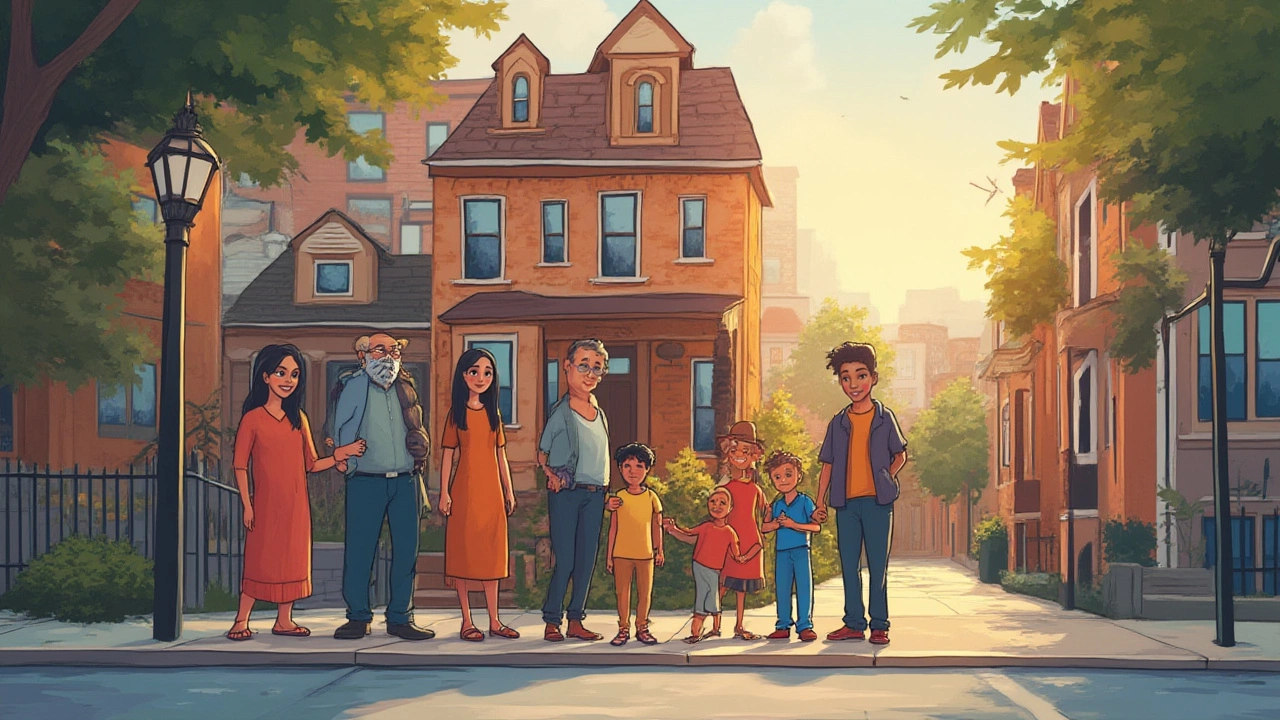Ever heard of people stuffing a dozen folks into a three-bedroom house? It happens more than you think, sometimes out of necessity, sometimes because, well, folks are just trying to save a buck. Baltimore County isn’t the Wild West, though — there are specific rules about how many people can live under one roof, and ignoring them can get landlords or tenants into a mountain of trouble. Zoning codes, safety standards, and health regulations truly shape who gets to call a rental home. If you’re looking to rent or lease out a property here, knowing these rules could keep you from headaches, fines, and even evictions. But that’s not the whole story: community pressure, neighborhood associations, and even nosy neighbors play into how these laws get enforced. That’s why it’s smart to get specific, so you’re never left guessing how many is too many in Baltimore County.
Understanding Baltimore County’s Rules on Rental Occupancy
People are often shocked to discover that your landlord—or maybe you, as a property owner—can’t just pack people into a house based on who wants to move in. Baltimore County, like many places, uses both local occupancy codes and broader standards to set maximums. Here’s the real kicker: these rules aren’t just arbitrary. They exist for safety. If a fire breaks out, too many bodies in too small a space can stall escapes and slow down firefighters, so the county has to set limits. Enter the International Property Maintenance Code (IPMC) and Baltimore County Zoning Regulations. These frameworks mesh together, creating the local law of the land.
For most of Baltimore County, the max number of unrelated people who can occupy a single rental is tied to the idea of a "family." But forget the old TV sitcom definition. Under county law, a "family" often means a group related by blood, marriage, adoption, or two unrelated persons living together long-term as a single household. More than two unrelated adults? That usually triggers extra legal hoops—special exceptions or boarding house permits. For example, piling four college buddies into a rental isn’t as simple as signing a lease together. The code, at the time of writing, limits unrelated adult roommates to two by default. But when it comes to families (with kids, cousins, grandparents all under one roof), the number is less about adults and more about square footage.
What about space? Here’s where the Baltimore County IPMC rules get specific. Each bedroom must offer at least 70 square feet for one person, and another 50 square feet per each additional person in the same room. Translation: if a bedroom’s got 120 square feet, you can house two people comfortably (70 + 50 = 120). Want to jam a third person in there? Not happening—unless you go wild with the tape measure. The code covers all sleeping areas—not just technically defined "bedrooms," but wherever people regularly crash at night. Living rooms, basements turned into makeshift bedrooms, converted sunrooms, you name it. The space rules still apply.
Bathrooms, kitchens, and exits are also scrutinized. You can’t just board up windows or convert a closet into a "suite." The law requires safe egress: a way out in case of emergency. Each person needs access to kitchens and bathrooms with appropriate capacity (no, a single tiny toilet for eight people doesn’t cut it). There are also requirements for heating, lighting, and ventilation. Baltimore County’s Department of Permits, Approvals and Inspections is stickier than a cat on a sunbeam about this—Luna, my own furball, would approve of the obsession with cozy, safe living).
If you’re a landlord, you’ve got extra skin in the game. Baltimore County periodically conducts rental inspections—especially if you’re dealing with multi-family dwellings or complaints roll in. Landlords found exceeding occupancy rules can get hit with fines that often start at around $100 and can soar much higher. Repeat offenders might even lose their rental licenses. Think it doesn’t happen? Check recent county dockets and you’ll see dozens of citations every year, often triggered by neighbor complaints about overflowing driveways, noisy gatherings, or suspicious door traffic.
Baltimore County rental limits apply to everyone: homeowners, tenants, and landlords alike. It doesn’t matter if folks are splitting rent or the homeowner’s niece is crashing indefinitely. Ignoring these statutes can also void housing insurance or affect liability in accidents. And don’t bank on a “but we’re all cousins” loophole—inspectors will want birth certificates, leases, and IDs if things get legal.
Here’s a quick at-a-glance look at some Baltimore County rental occupancy basics that everyone should know:
| Area of Law | Main Standard or Rule |
|---|---|
| Max unrelated adults per household | 2, unless special permit granted |
| Family definition | Related by blood/marriage/adoption or up to 2 unrelated people |
| Bedroom space per person | 1 person: 70 sq ft; Each add’l: +50 sq ft |
| Living/sleeping room min | Minimum total 120 sq ft for 2 people |
| Children occupancy | Square footage-based, not number-based |
| Zoning classification | Some zones more restrictive, single-family especially |
It pays to check your lease, too. Landlords in Baltimore County often write even more restrictive limits into their agreements—sometimes to meet HOA rules, insurance company demands, or just to keep the peace with neighbors who don’t want a frat house next door. The number on the lease is what counts in the eyes of the law.
Baltimore County code gets tweaked now and then, so it’s a savvy move to check the current statutes (the Department of Permits’ website lists updates) or to call in a local attorney if you want to bend the rules for a good reason. And if you’re in a pinch—maybe a short-term crowding situation while relatives visit or workers bunk up for a job project—it’s smart to keep things short-term and get landlord permission in writing.
Every year, the news covers yet another "overcrowded house" busted by fire marshals or shocked neighbors. Most people aren’t setting out to break the law. They’re just not aware the rules are this strict until someone knocks on the door to count pillows on the couch. Bottom line: renting in Baltimore County is pretty straightforward if you stick to the codes, but bending them (even accidentally) can get expensive fast.

Landlord and Tenant Tips: Staying Legal and Safe
It’s tempting to skirt around the edges—maybe you need that third roommate to cover rent, or you want to sublet a spare room on the sly. But even innocent mistakes in Baltimore County can throw everyone into hot water. If you’re a tenant, you can avoid nasty surprises by asking a few pointed questions before moving in. Ask the landlord outright about their max occupancy, and check if the house is licensed as a rental (yep, there’s an official registry). No license? Walk away. Illegal rentals come with zero tenant protections if anything goes sideways.
Landlords, listen up: screening prospective tenants isn’t just about credit scores. Ask applicants up-front how many people will live in the house—and get it in writing. If someone tries to sneak more bodies in after signing, that’s a code violation, and it could also let you terminate the lease. Some property managers use “resident verification policies”—sort of like check-ins for hotels but ongoing—for larger apartment properties, so watch for these if you’re renting a unit instead of a full house. If you’re a smaller landlord, run random visual inspections or maintain solid communication. It’s not about being nosy, but about not getting blindsided by a midnight fire marshal visit.
For college students or large, blended families, you have to get creative within the law. Often, renting a legal duplex, a bigger apartment, or two smaller rentals side-by-side works better than trying to wedge ten people into a single-family home. If your only option is a big group under one roof (maybe for a cultural reason or long-term family care), applying for a special use permit is the only legal ticket. These are rarely granted except in cases of clear community benefit, so don’t get your hopes too high, but it’s possible.
Insurance is another overlooked aspect. Crowded rentals frequently fall outside an insurer’s definition of a covered household. If the worst happens—think fire, burst pipes, or a dog bite—claims might be denied if investigators peg you as violating occupancy by-laws. Landlords can also face lawsuits if tenants or visitors get injured in over-packed homes. Even pets, like my own Luna, need to be listed on the lease if they count toward total occupancy calculations, which, occasionally, they do in restricted apartments!
Neighborhood association rules often build on top of county requirements. Some parts of Towson, Catonsville, and Pikesville are infamous for strict HOA rules limiting rentals to “single families only,” with hefty fines for violations. These get enforced even more harshly than county law—think garage inspections, parking pass crackdowns, or letter-writing blitzes from neighborhood busybodies. Always double-check HOA rules if you’re moving into an area with a community board, because they can override what the county allows.
So, what happens if you get caught breaking Baltimore County’s occupancy laws? Here are the realistic outcomes:
- Tenants might get evicted—often with as little as 30 days’ notice
- Landlords risk losing their rental license for repeat violations
- Fines: single infractions can cost hundreds, multiple violations can reach thousands
- Building condemnation in extreme cases (think real hoarding situations)
- Neighbors have legal standing to report you, and they often do
It sounds strict—and it is. Baltimore County’s not trying to single folks out, just keep housing reasonably safe and neighborhoods steady. But the reality is, if you need a packed household due to economic reasons, health, or culture, consider reaching out to local housing advocacy groups. They can sometimes mediate with landlords, advocate at hearing boards, or help you find lawful, creative solutions like shared housing or co-op living, provided it fits the local code.
If you’re planning to rent out your home or share with extra friends or family, make sure you understand the mix of occupancy limits, zoning rules, and liability risks before you sign anything or start moving folks in. It’s always easier to set things up right from day one than to sort it out when the sheriff knocks at 7am.

How Enforcement Works: What to Expect on the Ground
Plenty of renters and landlords in Baltimore County think they’re flying under the radar, but enforcement is surprisingly active. The county gets hundreds of complaints each year, most of them from neighbors who notice crowded driveways or too much foot traffic. County housing inspectors, fire marshals, and code enforcement officers regularly follow up. Sometimes it’s a quick visit, sometimes they dig deep, examining leases, interviewing residents, and measuring rooms with laser rangefinders (seriously).
If you’re facing an inspection, the process usually works like this: the inspector shows up—often unannounced but always with proper ID—and checks living spaces for egress, window sizes, smoke detectors, locks, and, most importantly, occupant numbers and use of rooms. If everyone’s legal, you’re in the clear. If not, you’ll get a written Notice of Violation—and a deadline to fix it, usually 30 days. For chronic offenders, it can escalate way faster, sometimes bringing in police or fire department support, especially if there have been complaints about noise, trash, or unsafe conditions.
Inspectors don’t care if people are on the lease, only who’s living there and how. You might think you’re clever keeping one roommate “off the books,” but inspectors check for beds, personal belongings, and signs of habitation. They’ve seen every trick. If you get caught with too many people, don’t expect to wriggle out with excuses like “She’s just visiting for the summer” or “He sleeps on the couch.” If someone’s there more than a few days a week, they count as an occupant in the county’s eyes (much like Luna thinks every visitor is here to see her).
The most common enforcement action is a fine and a warning to reduce numbers—fast. If conditions are unsafe (no exits, blocked windows, illegal wiring from makeshift bedrooms), the county can condemn the house immediately and remove everyone, which is about as fun as a popped water heater in winter. For landlords, three strikes on occupancy violations can mean permanent revocation of your rental license. For tenants, eviction for cause can follow as soon as the legal windows close.
The county also doesn’t mess around with appeals. If you think you’ve been wrongly cited, you can request a hearing with the Administrative Hearing Board, but success rates are mixed unless you’ve got tight documentation and clear proof. Sometimes, difficult cases end up in district court, especially if landlords keep violating codes and ignoring correction notices.
Interestingly, Baltimore County recently invested in new tech for code enforcement. There’s a smartphone app for submitting neighborhood complaints (it’s called MyNeighborhood) and a GIS-mapped database of code violations and rental properties that anyone can look at online. Transparency’s through the roof, so if you’re curious whether a house on your block is up to code, you can check public records before you move in—or before signing a lease as a landlord.
Does enforcement go after everyone? Not exactly. It tends to be heaviest in areas with lots of rentals, student housing, or recent complaints—think Towson, Essex, or Randallstown. More stable suburban blocks with owner-occupiers see fewer checks, unless something’s clearly off. Don’t count on slipping through just because you live in a quiet street, though. All it takes is one grumpy neighbor or a random inspection to spark an investigation.
So, to bring it back to the big question—how many people can rent a house in Baltimore County? The legal answer depends on how everyone’s related, the size of the house, local zoning, and what’s on the lease. In almost every case, you can’t squeeze more than two unrelated adults into one rental without lots of red tape, and even for families, the space-per-person rule is non-negotiable. Pushing boundaries isn’t worth risking your home, your wallet, or your peace of mind. Knowing and respecting these rules is the only way to keep everyone safe—and out of court.

